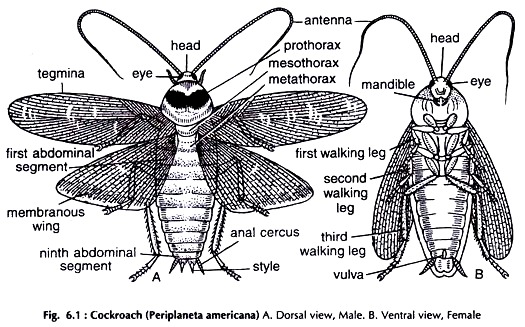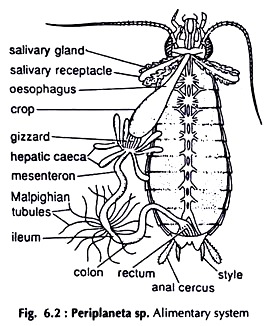In this article we will discuss about the dissection of cockroach. Also learn about:- 1. The Alimentary System 2. Dissection of Salivary Apparatus 3. Dissection of Nervous System 4. Dissection of Reproductive System.
Killing:
The cockroach is usually killed with chloroform. It can be killed successfully by drowning in water.
Dissection:
Hold the specimen (Fig. 6.1) with your left hand and clip the wings. Fix the specimen in a dorsal position on a dissecting tray with the help of pins passing through abdominal sterna and coxa of legs. Cut the lateral membrane (pleura) between the terga and sterna of the thorax and abdomen with a pair of fine scissors.
Posteriorly the two incisions should meet at the hindmost end of the abdomen. Proceed forward up to the anterior end of the thorax.
Give a transverse incision along the anterior border of the first thoracic segment and carefully remove the terga. The thoracic and the abdominal cavity are exposed. Put clear water in the tray. Remove fat bodies and tracheae to expose internal organs.
The Alimentary System:
Carefully uncoil the intestine and stretch the alimentary canal to one side (Fig. 6.2). Prevent it from coming back to the original position by pushing down a pin in the wax between the gut and the specimen.
Mouth:
Ventral in position, located at the base of the buccal cavity.
Buccal cavity:
An ill-defined chamber, bounded anteriorly by epipharynx and labrum; posteriorly by hypo-pharynx and labium; laterally by two mandibles (Fig. 6.5).
Pharynx:
A short, vertically oriented tube opening into the oesophagus.
Oesophagus:
A short tube running posteriorly in the thorax.
Crop:
There is no demarcation between the oesophagus and the crop. In fact, the crop is a large sac-like dilatation of the oesophagus. It extends into the abdomen.
Gizzard or proventriculus:
A round, thick walled muscular structure, posterior to the crop. It has two parts, the anterior contains six chitinous teeth in the inner wall and the posterior two circular hairy cushions.
Mesenteron or mid gut:
A narrow tube running from the gizzard to the hind gut. 7 to 8 hepatic caeca are present at the junction of the gizzard and mid gut.
Proctodaeum or hind gut:
A narrow tube, divisible into 3 zones – ileum, colon and rectum. The junction of the mid and hind gut is marked by 60 to 70 extremely fine, yellowish Malpighian tubules (The tubules are excretory in function.). The rectum opens through the anus.
Salivary glands:
Two in number. The glands and the receptacles lie on the dorsolateral aspects of the crop (Fig. 6.2). The ducts of the glands and receptacles run forward by the sides of the crop. The ducts from the two glands unite and those from the receptacles also unite to form two common ducts, which again unite and give rise to an efferent salivary duct opening on the ventral side of the hypo-pharynx.
Dissection of Salivary Apparatus:
Carefully remove all the tracheae and fat in the region where the salivary apparatus is lodged. Turn the crop as required and trace the ducts anteriorly running from the glands and the receptacles along the sides of the crop and then ventral to the oesophagus. Pin down the head of the cockroach with ventral surface upward.
Detach the glands and receptacles from the crop, separate the hypo-pharynx from the specimen by cutting it at the base and the salivary apparatus is free (Fig. 6.3). Carefully lift it with a spatula and place in a watch glass containing water. Mount it on a glass slide, if required.
Dissection of Nervous System:
Fix the head of the specimen by pinning through the mandibles. The rest of the body should be fixed to the wax of the dissecting tray in the way already described. Carefully remove the epicranial plate of the head capsule and expose the cerebral ganglia.
Cut the pharynx and pull it out with the oesophagus. Remove the viscera and the ventral nerve cord is exposed. Expose the roots of the circumoesophageal connectives on the lateral sides of the brain and trace them to the points where they meet the sub-oesophageal ganglia (Fig. 6.4).
Cerebral ganglia or brain:
The two fused to form a mass. A number of nerves arise from the ganglionic mass, which innervate eyes, antennae and the adjacent structures.
Circumoesophageal connectives:
Arising from the brain two short and broad nerves run around the oesophagus to meet the sub-oesophageal ganglia (Fig. 6.5).
Sub-oesophageal ganglia:
It is formed by the fusion of two ganglia and located in the mid-ventral region of the head just ventral to the oesophagus. Nerves arising from sub-oesophageal ganglia end in labrum, mandible and both pairs of maxillae. A pair of connectives run backward from the ganglia and join the first thoracic ganglion, (prothoracic ganglion).
Ventral nerve cords:
These are two solid nerves and run along the mid-ventral line of the thorax and abdomen. The nerve cords are connected by nine ganglia, three thoracic and six abdominal.
The three thoracic ganglia and the last abdominal ganglion are large in size. Nerves emanating from the thoracic ganglia innervate the musculature and structures of the thoracic region. Those from the abdominal ganglia send nerves to the structures in the abdominal region.
Stomatogastric or Anterior Sympathetic Nervous System:
It consists of a median frontal ganglion, hypo-cerebral ganglion, oesophageal and ingluvial ganglion (Fig. 6.6).
i. Frontal ganglion:
Situated in front of brain, on the oesophagus, median in position. Connected to tritocerebral lobes of brain by a pair of frontal connectives.
ii. Hypo-cerebral ganglion:
Situated on the oesophagus below the brain. Recurrent nerve connects frontal and hypo-cerebral ganglion.
iii. Oesophageal or pharyngeal or occipital ganglion or corpora cardiacum:
Situated on both sides of oesophagus slightly above the hypo-cerebral ganglion. From hypo-cerebral ganglia nerves go to corpora cardiaca or oesphageal ganglia. From corpora cardiaca of each side nerve connects ventrally to another ganglia corpora allatum.
iv. Ingluvial or Stomachic ganglion:
Situated on the posterior end of the foregut. Nerves from hypo-cerebral ganglion connect the ingluvial or stomachic ganglion. The nerves from ingluvial ganglion innervates the neighbouring regions of the stomodaeum.
Dissection of Reproductive System:
The sexes are separate. A pair of anal styles are present in male cockroach.
Male Reproductive System:
(Fig. 6.7)
Care should be taken while removing the terga. The paired testes are situated just beneath the 4th and 5th abdominal terga. The colour of the testes blends with the colour of the surrounding fat and it is difficult to distinguish them from the latter.
Testes:
Paired, small in size, made up of a number of vesicles.
Vasa deferentia:
Two narrow tubes. Arising from the testes run posteriorly and join to form the muscular ejaculatory duct.
Ejaculatory duct:
It opens in a median genital armature, opening through male gonopore.
Mushroom-shaped gland:
A vesicle is formed by the swelling of each vas deferens before joining the other. Numerous, slender, blind diverticula are given out from the vesicles and the structure looks like a mushroom. The central region of the gland with smaller rounded diverticula is known as utriculi breviores and two lateral region with slender vesicle as utriculi majores.
Conglobate gland:
Median, ventral to the ejaculatory duct and associated with it.
Female Reproductive System:
(Fig. 6.8)
Ovaries:
Paired, located under the 4th and 5th abdominal terga. Each ovary has 8 tubules, the ovarioles, which are held together.
Oviducts:
Two, short, wide tubes. The ovarioles unite to form the oviduct. The two oviducts join posteriorly and form a muscular tube, the vagina.
Vulva:
It is a slit-like external opening of the vagina.
Colleterial glands:
A pair of much branched glands opening on either side of the vulva.
Spermatheca:
A median sac opening into the genital pouch.







